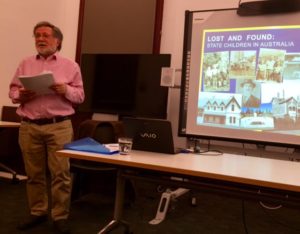Paper presented to the Hotham History Project, North Melbourne Town Hall, 25 July 2017
I am posting this very long paper in separate sections so as not to tax my readers too much. It should be noted that the paper was presented to an audience with a particular focus on the history of North Melbourne and neighbouring suburbs and that influenced my choice of institutions to illustrate policy and practice.
ABSTRACT
The difficult question of what to do with children who can’t or shouldn’t live with their families has troubled Australian society from the beginnings of European settlement. Despite innumerable formal inquiries, problems persist. This paper examines the mixed motivations of welfare authorities and the way they framed the problem over the years to explain the different kinds of institutional responses. To illustrate the issues, the author uses examples geographically close to North Melbourne and draws on research into his own multi-generational history of a family in state care. The lack of resources dogged the hybrid child welfare system, but the lack of a clear or consistent rationale for child removal was more intractable—and remains so.
- INTRODUCTION
From the earliest days of the European presence in Australia, child removal and protection has been a confronting challenge—and remains so. Many of the 50 children on the First Fleet were in need of government care and protection.[1] I don’t have time tonight to discuss the first Australian orphanage on Norfolk Island in 1793, or the early orphanages in Sydney and Parramatta. I’ll stick to Victoria—and in particular to inner Melbourne.
Over the course of Australia’s settlement history there have been more than 1,000 children’s Homes—more than 300 of them in Victoria alone, including a number within reasonable walking distance of North Melbourne, and I will talk about them to illustrate the broader trends in the history of child welfare in Australia.
In the period 1928 to 1989 alone, more than 500,000 children were in out-of-home care in Australia. As we speak, some 45,000 Australian children are not living with their own families—and, it’s appalling that around a third of these children are Indigenous Australian children. In 2004 there were just under 22,000 children in out-of-home care (OOHC) while in 2016 that number had jumped to 45,000.

In 2009 Prime Minister Rudd described the treatment experienced by Australian children in out-of-home ‘care’ in the 20th century as ‘an ugly chapter in our nation’s history’.[2] The current Royal Commission into child sexual abuse should not be assumed to mean we have only recently discovered that many of the very people charged with caring for children abused those children. There have been more than 80 inquiries before this Royal Commission.[3] Our nation has struggled with unresolved problems in providing compassionate care and protection for its most vulnerable children.
In 2016, Victoria Legal Aid undertook a review of Child Protection Legal Aid Services and found
strong agreement that the removal of a child from the family is one of the most serious actions that the State can take, and should be a last resort.[4]
So, when is it right and proper to remove a child from the family home? Some of the circumstances where, historically, children have been removed include:
- When both parents die, or one parent dies and the surviving parent is unable or unwilling to care for their child (a clear minority of cases);
- When the parent is unable or unwilling to care for a child—temporarily or permanently—because the parents are ill, disabled, deserted, divorced, damaged by war service or otherwise unable to care for them;
- When the child commits an offence deemed to be sufficiently serious to warrant incarceration;
- When the state judges the parents ‘unfit’, e.g. in gaol; mentally ill; abusive or neglectful; racially or mentally inferior; disabled, homeless, chronically impoverished, or unwed—usually mothers.
Each one of the above circumstances has been part of Australia’s history of child welfare. Indeed, some are part of my own family’s history. On my mother’s side of the family some 30 children were lost to the Welfare over five generations—and through the study of welfare history, I have been finding that lost family again. I’ll mention a few examples as we proceed.
Over the years, Victorian governments produced an odd hybrid system run by government and non-government agencies, churches and charities, community bodies and even private enterprise operating diverse institutions—general asylums, large orphanages, industrial schools and reformatories, small-scale charitable Homes, boarding-out or fostering, cottage and group homes, hostels, lead tenant arrangements, and adoption.
—————————————————————————-
[1] Robert Holden, Orphans of History: The forgotten children of the first fleet, Text Publishing, Melbourne, 2000.
[2] National Apology to the Forgotten Australians and former Child Migrants, 16 November 2009 http://parlview.aph.gov.au/mediaPlayer.php?videoID=314492&action=download#/3
[3] Shurlee Swain, History of Australian inquiries reviewing institutions providing care for children, Royal Commission into Institutional Responses to Child Sexual Abuse, Sydney, 2014.
[4] Victoria Legal Aid, Child Protection Legal Aid Services Review – Consultation and options paper 2016: p 23: http://www.legalaid.vic.gov.au/sites/www.legalaid.vic.gov.au/files/vla-child-protection-legal-aid-services-review-consultation-and-options-paper.docx
